Otavalo Market – A Full Guide to Ecuadors’ Biggest Market

Wondering how to get to Otavalo Market, what to buy, and when to go?
We found the Otavalo Market in Ecuador to be an incredible place filled with handmade crafts, local delicacies, vibrant colours, and unmissable culture. Once you’ve arrived at the market, it’s easy to see why so many travellers have been enchanted by it over the years.
We went in May 2023, and it was such an incredible visit.
This guide will help you make the most of your time in this magical market and explore every corner.
Short on time? Book your trip to Otavalo Market now:
Tours
- Book an amazing all-day tour full of highlights, including Otavalo Market!
- Find your bus ticket to Otavalo on BusBud!
Accommodation
- 📍 Budget option: Hostal La Rosa Otavalo
- 📍 Mid-range option: Hostal Riviera Sucre
How to get to Otavalo from Quito
Getting from Quito to Otavalo might be a little confusing. I’ll provide a detailed guide to getting to Otavalo Market, so grab your backpack and let’s get started!
Where is Otavalo?
Nestled in the Andean highlands of Ecuador, the town of Otavalo is about 2 hours to the northeast of Quito.
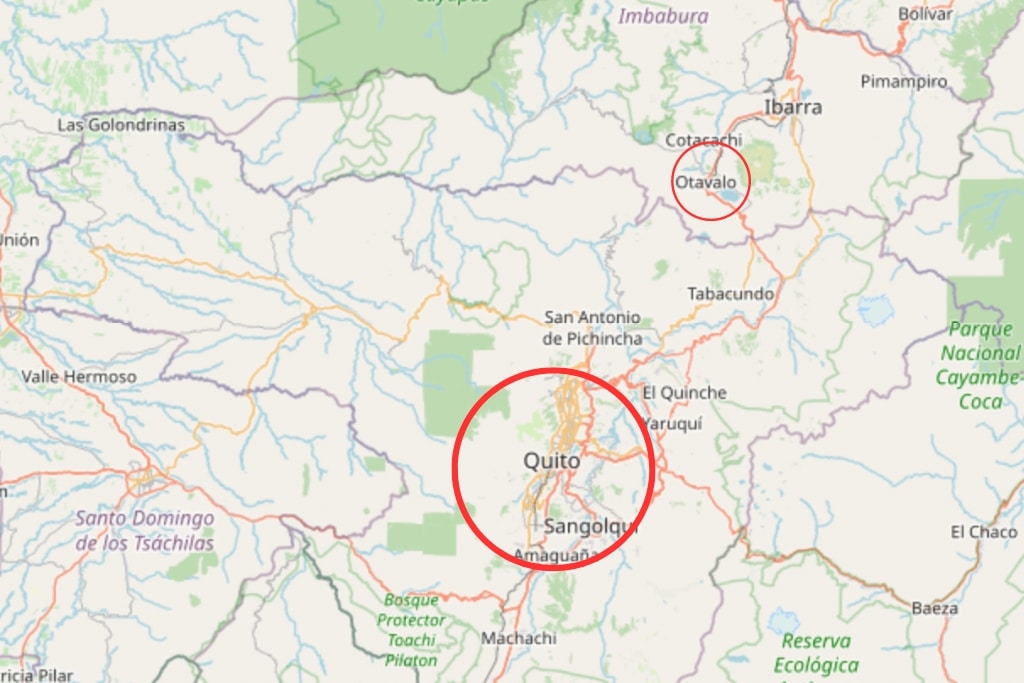
Option #1: By tour
Taking a tour might just be the best way to experience everything this market has to offer. A tour can help you get the most out of your trip.
You won’t have to worry about getting there and back, and the guide will help you find the items you’re looking for. Explaining the Ecuadorian culture along the way.
We opted to do a full-day trip. Visiting the middle of the world (fun fact: Mitad del Mundo is not actually on the equator line), and nearby towns, lakes, and volcanoes.
Best tours
There are two different tours available to visit the market. Ones that just visit the market, and the others that take you along on a full-day trip visiting many other places.
All-day tour with multiple stops
We picked this tour, which takes you to the middle of the world, a bakery that makes the local treat of bizcochos, multiple lakes and volcanoes, and includes a traditional lunch. Oh, and of course, the Otavalo Market!
⭐️ Book this amazing all-day tour full of highlights right here!
Otavalo Market tour
Some tour shops also offer transport to just the market. They give you enough time to explore the market!
These tours are not available online, so you should shop around Quito and find the right one for you. Of course, this will be cheaper than doing an all-day trip, but not that much!
My recommendation would be to go for the all-day tour. Honestly, it’s been one of the best tours we’ve done in our 6 months of backpacking!
Private tour
Private tours can be a great option when visiting a popular destination like the Otavalo Market. You’ll get a personalized experience because you’ll have the flexibility to customise the places you visit. Not feeling a stop, just skip it.
Overall, a private tour can help you make the most of your visit to Otavalo Market, ensuring you have a personalized, comfortable, experience.
⭐️ Book this AMAZING private Otavalo day trip now!
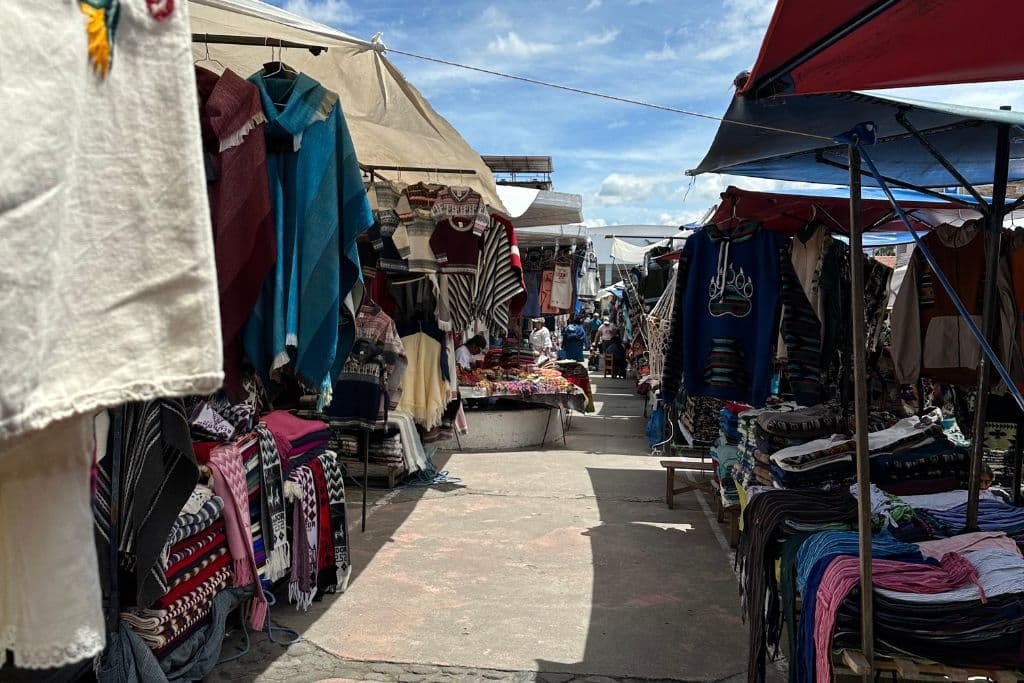
Option #2: By bus
The cheapest way to get to Otavalo would be going by public bus. I’ll tell you how:
Quito to Otavalo
Getting from Quito to Otavalo by public bus is relatively easy and affordable. Here’s a step-by-step guide on how to do it:
- Head to the bus terminal in Quito: The bus terminal, known as “Terminal Terrestre Carcelen,” is located in northern Quito. You can take a taxi, Uber, or public transportation to get there.
- Once you arrive at the terminal, look for the ticket booth that sells bus tickets to Otavalo. It’s indicated on top of the booths, so this should be easy!
- Walk up to the ticket booth and purchase your ticket to Otavalo. The cost is $2.50 per person. On your ticket, you’ll find your bus number and seat number.
- Check the departure time on your ticket and board the bus. Your bus will likely depart from platform 1 or 2 since they are for bus company Coop. Otavalo. If not sure, just ask: ‘¿Cual plataforma?’.
- Enjoy the ride! The journey takes around two hours, depending on traffic. You’ll see the beautiful Andean countryside on your journey and get a glimpse of rural life in Ecuador.
- Once you arrive in Otavalo, you can get off the bus at the main terminal. From there, you can explore the town’s famous Otavalo Market!
Taking the public bus from Quito to Otavalo is a safe, reliable, and cost-effective way to travel. Just make sure to keep an eye on your belongings and follow safety precautions, especially if you’re travelling during peak hours.
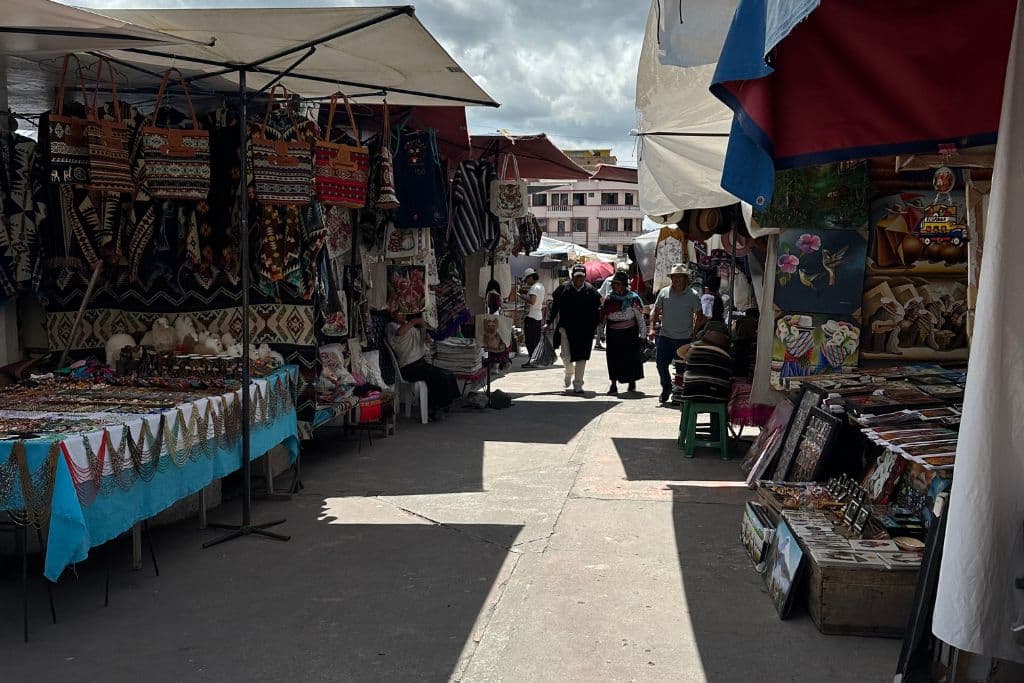
Otavalo to Quito
Getting back is just as easy as getting to Otavalo. Just head back to the bus terminal you arrived at. There is a ticket booth for Quito, but in typical South American style, you’ll notice people shouting “QUITO, QUITO!” at you, to try and get you on the next bus to Quito. You won’t need a ticket this time, as you can just pay on the bus.
If there is no bus at the platform, just head to the ticket office for a ticket!
Option #3: Drive yourself
Renting a car is also a great way to visit Otavalo Market and the surrounding area. The roads are safe, and although traffic can be a little chaotic, it’s definitely not as bad as in the neighbouring countries.
Depending on the dates and length of your rental, you can find rental cars for about $65 per day. It’s about the price of a day trip for one person, so it could be cheaper to drive yourself if you’re travelling with others!
🚗 Discover Cars is THE best platform to find your affordable rental cars today!
How far is Otavalo from Quito?
Otavalo is only a 2-hour drive northeast of Quito. Expect pretty, windy roads through valleys, towns and other communities!
On the way, you’ll find lakes, volcanoes, mountains, and overall beautiful nature.
Some stops on the way to check out when driving yourself:
- Quitsato Solar Clock – Visit and learn about the equator, solar clocks, and astronomy, and visit the biggest agave garden in South America.
- Mirador Rumi Loma – for a view of San Pablo Lagoon and Imbabura volcano
If you are planning to visit the Galapagos while in Ecuador then check out this itinerary!
The Market
Once you’ve visited some stops you’ll find yourself at the Otavalo Market! This market is often one of the reasons people visit Ecuador. Be sure to spend enough time here to visit all the market stands. We spent about 1,5 hours, which was a little short if you want to do some proper shopping. At least 2 hours would be perfect in my opinion.
Plaza de Ponchos
On most market days, the market is concentrated on Plaza de Ponchos. This is the centre of the market. Also known as the Tourist Market. Not only for foreign tourists, since locals like to shop in this square too. On Saturdays however, the market branches out to the whole city centre.
History & Traditions
The Otavalo Market has been around since pre-Incan times. So the market dates all the way back to the fifteenth century! All this time, the Otavaleños have been skilled weavers. Creating ponchos, blankets, and other things to keep them warm during the cold Andean nights.
This is nowadays what the market is most famous for. Handmade crafts and clothing. I scored a great poncho for our future trip to Peru and Chili!
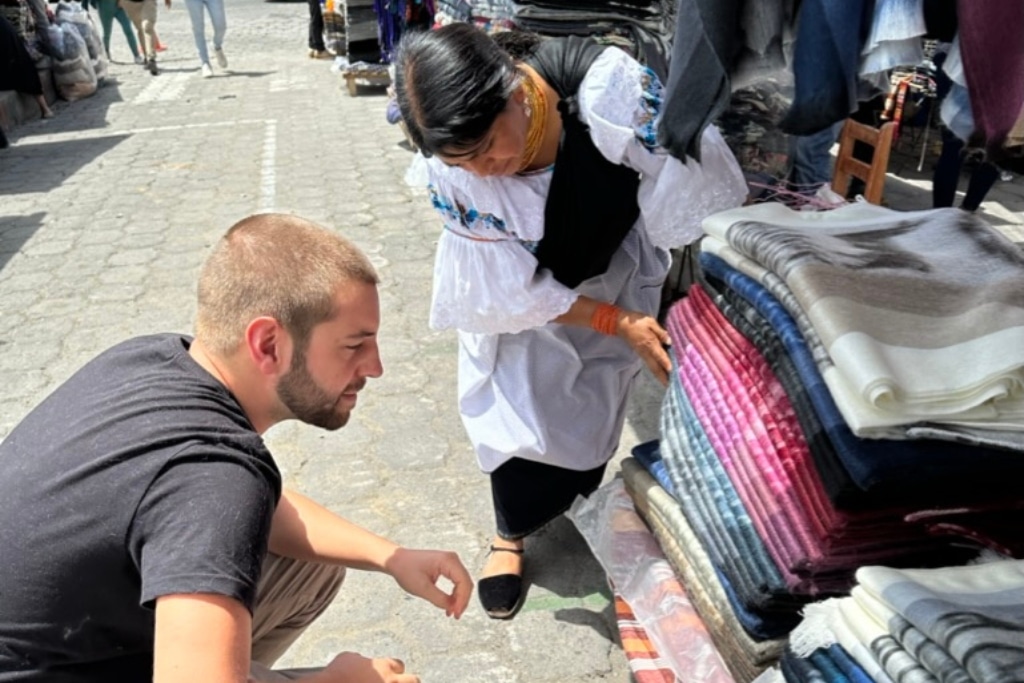
The Best Time to go to Otavalo Market
June till September are the dryest months of the year. Since Ecuador is on the equator, temperatures don’t really change. They only have a wet, and dry season.
The wet season officially starts in October and lasts all the way to May. But, it’s highly uncommon to have rain all day. Even in the dry months of June till September you can expect a light drizzle every now and then.
Market days
The market is held every day from 7 am to 6 pm. However, if you have the choice, Wednesdays and Saturdays are the best days to visit. On Saturday the Otavalo Market expands from Plaza de Ponchos to all of the city center.
We visited on a Saturday and were absolutely astounded by the sheer amount of market stalls.
Otavalo Market Tips
Depending on where you’re from, this market might be a little different than the markets you’re used to back home. It’s slightly chaotic, and you’re expected to haggle.
Haggle, bargain, and barter!
Haggling is not in everyone’s nature. Especially not mine! Where I’m from, it’s just not a thing you do. You just pay the price that is advertised.
In Otavalo however, you’re expected to haggle. If you don’t you are 100% overpaying. The shop owners inflate their prices because they expect people to try and get them down.
Haggling 101:
- Don’t buy the first item you see. There are many stalls selling similar products. So walk around and politely inquire about their prices. Take note of these to get a general idea of asking prices.
- Negotiate! Once you find something you like, inquire about the price. The price WILL be inflated because haggling and bargaining are the market’s culture. If you agree on the first price they offer, it could even be seen as disrespectful.
- Don’t go too low with your counteroffer to avoid insulting the seller. If someone is asking $20, don’t offer $3, but start with $10. Generally, halving the first price is accepted.
- Try to settle on a price between 25% to 35% lower. Normally, this is the price it should’ve cost in the first place. You’re expected to buy $20 items for anywhere between $12-$15.
- Be prepared to walk away. If you really don’t like the price they’re asking after haggling, just walk away and try somewhere else. Usually, they come back with one last offer. If they happily let you walk away, your price was probably too low.
- If possible, buy in bulk! If you get the price down to, let’s say, $15, You can often get two for $25.
- Have small notes or coins ready. It’s a little insulting if you’re driving a very hard bargain, to then pay with a much larger note than the price you agreed on. Also, the sellers will be thankful for any small notes they can use as change for their next customers.
- Enjoy yourself, and make sure the sellers enjoy themselves too. In the end, you want to spend a little less money, and the seller needs to make some. Don’t go too crazy. If you think a price is fair, why go any lower? In the end, the sellers are there to make money.
What’s for sale?
Looking for any specific items? Or just wanna stroll around and see what’s happening? These are the main things that are for sale.
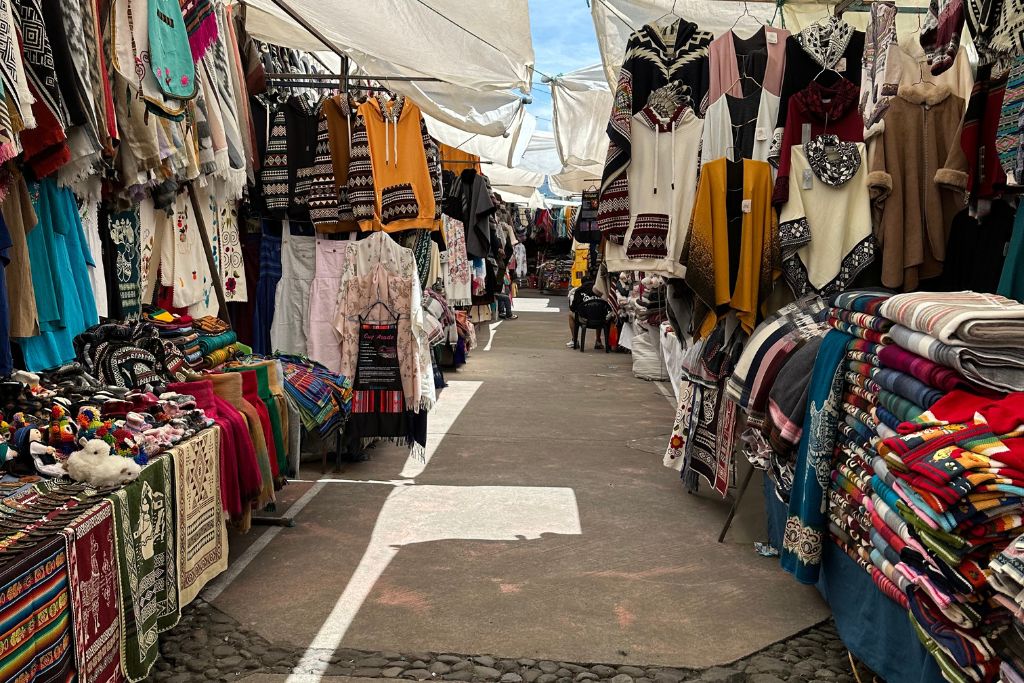
The best textiles and clothes
Hand-made ponchos, embroidered shirts, blankets, trousers, dresses, blouses, and so much more. If you’re in need of any textiles, Otavalo Market is the place to be.
Callie bought some cute dungarees, and I went home with an alpaca-wool poncho.
Alpaca & Lama wool
Westerners are usually not very experienced when it comes to these wool types. This means the sellers will try to sell you lama-wool products as if they’re their alpaca counterparts.
The easiest way to spot the difference is by feeling. Go to a few stalls and feel their products. One will feel significantly softer and smoother. That’s the alpaca wool. It’s also warmer since the fibres are hollow and trap air for insulation.
Alpaca wool is slightly more comfortable and a lot warmer, so a bit more expensive. This is why you should check the difference when buying items.
Crafts & Souvenirs
Jewellery, accessories, decorations, handbags, tote bags, you name it. It’s all for sale on Otavalo Market. They’re pretty and well-priced.
Make sure you’re allowed to take the items back to your home country, though. Some items are made of wood or corals and are prohibited to import without certification. This differs per country, so check your local laws.
Fruits, Vegetables & Other Foods
There are lots of fresh products for sale. And cheap! We didn’t haggle for prices here, since you buy 24 bananas for only $1. And more lychees a person could eat for $0.50.
If you’re staying around Otavalo or Quito for a few days like us, this is the time to buy fresh produce. We went home with vegetables to make a few days’ worth of meals. It was a lot cheaper than in Quito.
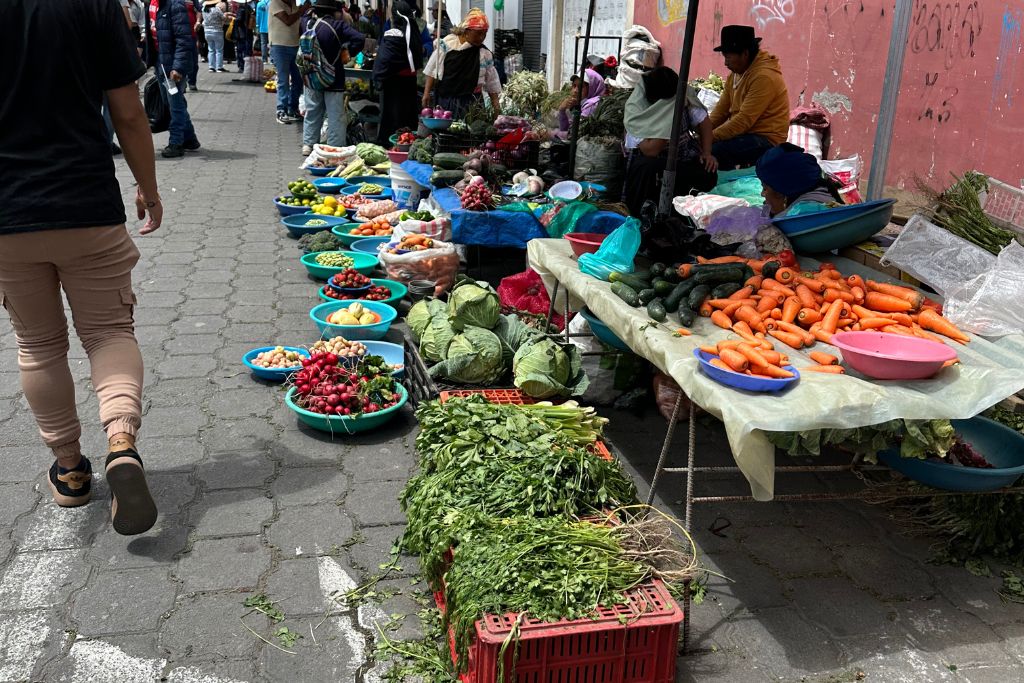
How to pay
Although very few stalls have card machines, don’t expect to pay by card. Take cash, and preferably smaller notes and coins. The sellers will thank you!
There are some ATMs around Plaza de Ponchos.
Other things to do in Otavalo and the Area
There are plenty of things to do in Otavalo beyond the market. I’ll name the best ones:
Peguche Waterfall
Peguche Waterfall is a breathtaking natural attraction located just a short distance from the town of Otavalo. It is a popular destination for both locals and tourists because of its beauty and the chance to swim in its waters.
The waterfall is approximately 18 meters (60 feet) high and is surrounded by greenery and rock formations, making it an ideal spot for nature lovers. Visitors can hike on the well-marked trail that leads to the falls, which takes about 30 minutes to complete.
Cotacachi-Cayapas Ecological Reserve
Cotacachi-Cayapas Ecological Reserve is a protected area known for its diverse ecosystems, including Andean cloud forests.
Visitors can explore the reserve on guided tours or by foot, take a boat ride around the Cuicocha crater lake, and learn about local culture and traditional activities.
Parque Condor
Only 10 minutes outside of Otavalo you’ll find this bird rehabilitation center. They rescue a variety of birds, such as eagles, owls and condors.
Parque Condor is a bird rehabilitation centre located in Otavalo, Ecuador. It specializes in the rehabilitation and conservation of birds of prey, including eagles, hawks, owls, and vultures.
It aims to rescue and rehabilitate birds that have been injured or illegally captured for the black market. Once the birds have recovered, they are released back into the wild.
Weaving workshops
Because Otavalo is famous for its traditional textiles, you can participate in weaving workshops to learn about the process and create your own unique textiles. The workshops are led by local artisans who have been practising their craft for generations, using ancient techniques and traditional materials.
During the workshops, you’ll learn about the different types of fibres used in weaving, such as alpaca, llama, and sheep wool, and how they are processed and dyed using ingredients like plants and minerals.
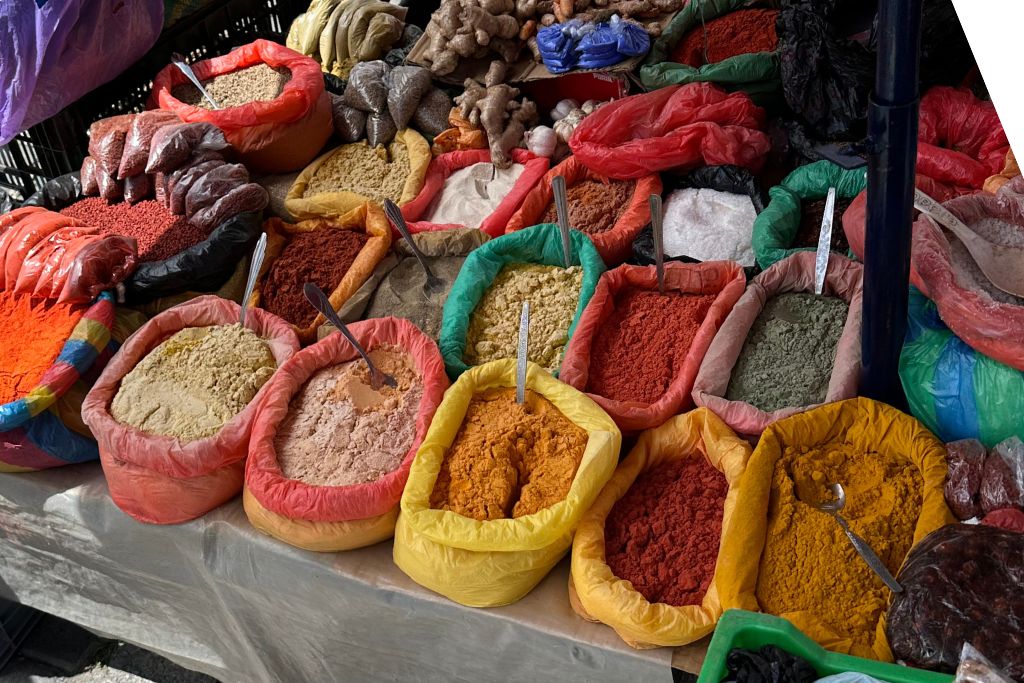
Museo de Arte Precolombino Casa del Sol
Museo de Arte Precolombino Casa del Sol (Casa del Sol Pre-Columbian Art Museum) features a collection of pre-Columbian items and art from the area, including ceramics, textiles, gold and silver objects, and sculptures.
The museum covers the history and culture of the indigenous people who lived in the Andean region before the arrival of the Spanish.
If you have more time on your travels to explore further afield, make sure to check out our Peru Itinerary.
Where to stay in Otavalo
There is so much to do in Otavalo besides the market, it’s worth spending a couple of nights. These are my recommendations for hotels:
📍 Budget option: Hostal La Rosa Otavalo
This highly affordable hotel offers comfortable, spacious private rooms with bathrooms. In a great location close to the market.
✅ Book your affordable stay in Otavalo now!
📍 Mid-range option: Hostal Riviera Sucre
A tiny bit further out of the centre, but that means it’s a lot quieter. This picturesque, colourful hotel includes breakfast in the price.
✅ Book this colourful hotel here!
📍 High-end option: Doña Esther Otavalo
A beautiful courtyard and a great breakfast are included in the price. Pretty, comfortable rooms and hot showers. Close to the market and restaurants. What else do you need?
✅ Enjoy Hotel Doñ Esther Otavalo right now!
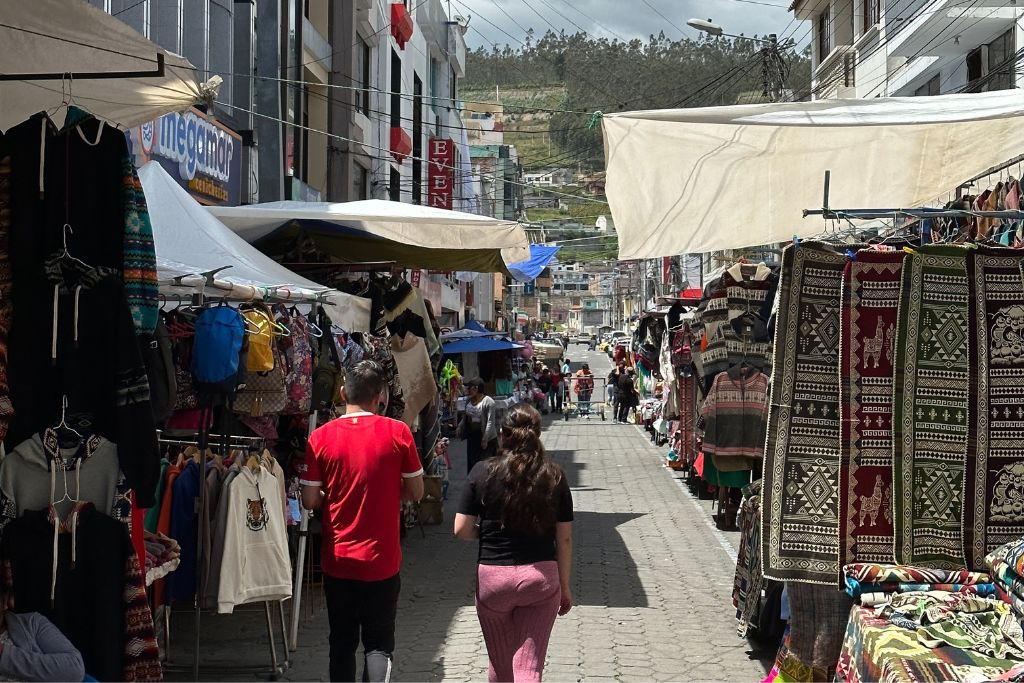
Safety Tips for Otavalo Market & Ecuador
Safety is highly important, so here are some tips for Otavalo Market, and Ecuador in general:
- Be aware of your surroundings: Otavalo Market can be crowded, so it’s important to keep an eye on your belongings and stay alert for any suspicious activity.
- Use caution when carrying valuables: Avoid carrying large sums of cash or wearing expensive jewellery, as these can make you a target for pickpockets and thieves.
- Follow local customs and traditions: Ecuador has a rich cultural heritage, and respecting the customs and traditions of the locals is important both for safety and for showing respect.
- Know local emergency numbers: It’s always a good idea to know the local emergency numbers in case of any accidents or emergencies while visiting Otavalo Market or anywhere else in Ecuador.
- Stay hydrated: Ecuador’s climate can be warm and humid, so it’s important to drink plenty of water and stay hydrated while exploring Otavalo Market and Ecuador.
- Dress appropriately: Dress in comfortable clothing and wear appropriate footwear for walking on uneven terrain. Also, be mindful of the local customs and traditions when it comes to clothing choices.
- Use official taxis or transportation services: Only use official taxis or transportation services, and avoid accepting rides from strangers or unlicensed vehicles, as this can be unsafe.
- Keep important documents safe: Keep your passport and other important documents in a secure place, such as a hotel safe, and don’t carry them with you unless necessary.
- Be mindful of altitude sickness: Otavalo Market is located at a high elevation, which can cause altitude sickness in some visitors. Take it slow and allow yourself time to adjust to the altitude, and consider consulting with a doctor before travelling if you are concerned about altitude sickness.
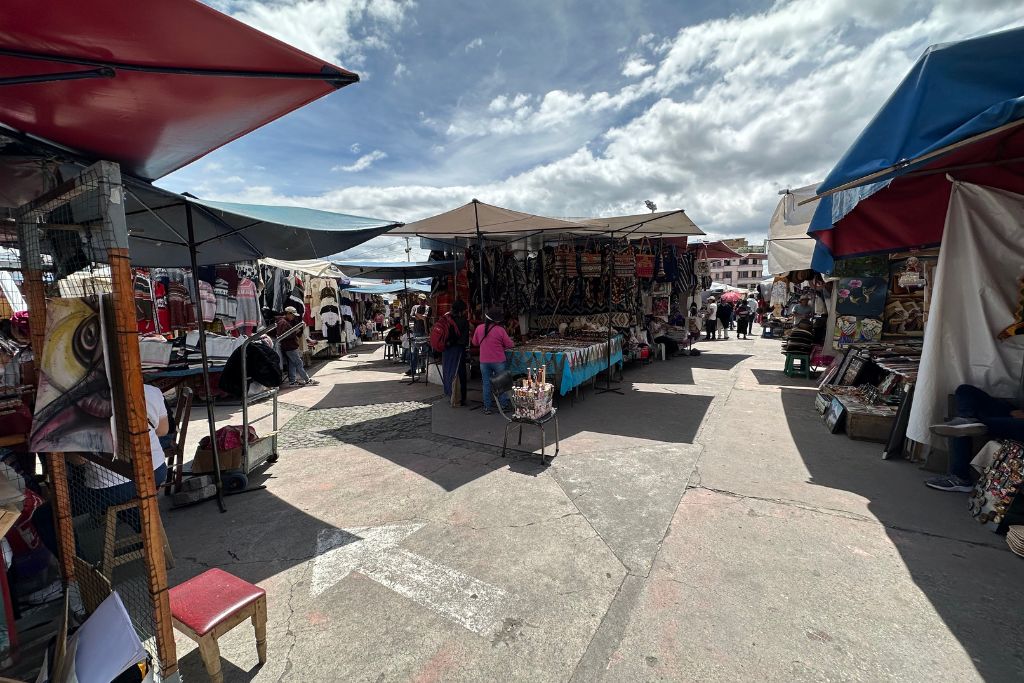
Otavalo Market – Final Thoughts
The market is a great place to indulge yourself in local culture. And to buy affordable clothes and accessories. Getting there, luckily, is quite straightforward.
Please let me know what your experience was, and show off any goodies you bought!
